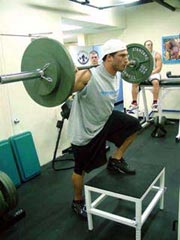 Back in September 2006 I took a look at an exercise which doesn't seem to attract the attention it deserves - the barbell step-up. If you haven't tried it, it's definitely time to give it a go.
Back in September 2006 I took a look at an exercise which doesn't seem to attract the attention it deserves - the barbell step-up. If you haven't tried it, it's definitely time to give it a go.
One further point before the article itself : despite the title, I perform both step-ups and squats (as do many Olympic weightlifters). In my opinion, they both deserve to be widely known.
The Step-up - a real squat alternative?
In the 1920s - particularly in the US - weight training began gaining favour with the public at large, and the Step-up began finding itself in various books and magazines. However, the back squat gradually started to dominate (largely due to the efforts of the German Henry 'Milo' Steinborn and Joseph Curtis Hise) and the Step-up was all but forgotten.The Step-up seems to have been largely overlooked as a weight-bearing exercise for the thighs - primarily due to the dominance of the back squat. This article may just make you reconsider its use.
What is it?
The Step-up - as the name implies - is nothing more complex than stepping up onto an object, then stepping back down from it. Although it is an incredibly simple exercise, there are a few things to be aware of.
Factors to consider
Perhaps the most important of these is the height of the step. The basic exercise works the hips and thighs, and the step height adjusts things in favour of the quadriceps or hamstrings. A higher step works the hamstrings harder, a lower step targets the quads (1).
According to Anatoly Bondarchuk, the 'normal' or ideal step height (for those with perfectly balanced quad and hamstring strength) is such that when the leading leg has the foot flat on the step, and the corresponding thigh parallel to the ground, the trailing leg has the toes just touching the ground (but the heel elevated) (1). This will naturally vary from person to person, and the use of a weight plate is common to bridge small gaps (it's unlikely that your training partner will have exactly the same requirements as you).
In addition to the step height, speed and number of reps both play crucial roles in determining the effectiveness of this exercise (for your personal goals). The usual rules apply - in general the reps will be lower and the breaks longer when training for maximum strength, and the reps higher/breaks shorter for hypertrophy goals.
The starting/finishing distance of the feet from the step also makes a difference, with a larger gap emphasising the Gluteus Maximus and a smaller gap emphasizing quadriceps (2).
Muscles used
The target muscle group is usually the quadriceps, though the weighting of this can be adjusted by altering the step height and gap as indicated above. Other muscle groups involved are (2) :
Synergists
* Gluteus Maximus
* Adductor Magnus
* Soleus
* Gastrocnemius (Second Leg)
Dynamic Stabilizers
* Hamstrings
* Gastrocnemius (First Leg)
Stabilizers
* Erector Spinae
* Trapezius, Upper
* Trapezius, Middle
* Levator Scapulae
* Gluteus Medius
* Gluteus Minimus
Antagonist Stabilizers
* Rectus Abdominis
* Obliques
As you can see, this is well and truly a compound exercise, and targets similar muscle groups to the squat.
Variations
Bodyweight step-up
The simplest form is a bodyweight-only step-up onto anything of a reasonable height (usually something below knee height). The speed, number of reps and step height will all play roles in the effectiveness of this exercise for your goals. Because of this flexibility the step-up can be used as a warmup, conditioning or strength training exercise.
Dumbbell step-up
As per the bodyweight step-up, performed whilst holding a dumbbell in each hand.
Barbell step-up
As per the bodyweight step-up, performed whilst holding a barbell across the shoulders in the same manner as for a back squat.
Step-ups wearing a weight vest
As per the bodyweight step-up, performed whilst wearing a weight-vest (such as the V-Max).
 Former East Bengalese marathon runner Sri Chinmoy (pictured) switched to weight-lifting in the mid 1980s (when he was in his 50s); setting a personal record for Step-ups done whilst wearing a 50lb weight vest by regularly performing 100 in 1996 (aged 65). Once again, the usual rules of rep ranges and breaks apply.
Former East Bengalese marathon runner Sri Chinmoy (pictured) switched to weight-lifting in the mid 1980s (when he was in his 50s); setting a personal record for Step-ups done whilst wearing a 50lb weight vest by regularly performing 100 in 1996 (aged 65). Once again, the usual rules of rep ranges and breaks apply.
Inspired by Chinmoy's effort, the slightly more spritely Ashrita Furman (6) completed 2,574 step-ups (bodyweight only) onto a 15" bench in one hour, later that same year.
Performing the step-up
Although almost any form of step is suitable for bodyweight step-ups, a large flat surface will be increasingly necessary as the weight lifted climbs up. One solution - which enables a quick changing of height - is a Step-Up Bench Accessory, such as this one from Gill Athletics.
For bodyweight-only or dumbbell step-ups, the pins (of a power-rack) themselves are a quick and often handy step.
When using a weighted bar, begin with the same stance and bar position as for a back squat. As you step up onto the box/bench/step, keep the torso as erect as possible (try to keep the shoulders roughly over the hips throughout the movement). On descent, slightly bend the leg you're coming down on to (it'll reduce the shock and increase safety).
Comparisons to Squatting
I realise that powerlifters are not going to suddenly stop squatting in favour of performing weighted step-ups. However, there are a couple of benefits to the step-up which might favour their inclusion in your routines :
- The weight used in a barbell (or heavy dumbbell) step-up is much less than that of a heavy squat performed by the same lifter (1). This difference alone greatly reduces the stress inflicted on the lower back.
- The step-up eliminates the bounce which is sometimes used during a squat (particularly in the deep squatting favoured by bodybuilders and Olympic weightlifters). This lack of bounce reduces the impact to knees.
Working them in
Perhaps the most obvious way to incorporate them in your routines is to simply replace squats with step-ups. Realistically, though, there are a couple of things to consider :
- Look at your current quad : hamstring strength ratio. Although theories differ as to the 'perfect' ratio, the figures suggest that the hamstring muscles should be approximately 60-80% as strong as the quadriceps muscles. Failure to maintain that ratio increases the risk of injury.
The relative strengths of these two muscle groups are usually tested using two exercises you may or may not already be using in your workouts - Leg Curls and Leg Extensions.
If the quads are much stronger than the hamstrings (according to the above tests), a higher step should be used. Conversely, if the hamstrings are found to be stronger, a lower box should be used. - What are your goals? Are they leaning more toward hypertrophy, mobility or absolute strength? Step-ups are effective in the same rep ranges as squats - whether you choose to use sets of 1 or 100.
The Bulgarian team used (and possibly still do) the pulse rate as the primary indicator of when to increase the weight. Following warm-ups and a bodyweight-only set of 8-10 reps, triples (with increasing weight) are used. Following each set a pulse rate of 162-180 bpm is expected, and the next set not started until this has reduced to 102-108. Success has been had by Russian (and later Bulgarian) Olympic weightlifters who included healthy doses of step-ups in their training. An excellent example of this is Bulgarian Leonid Taranenko, who successfully lifted 266 kg (586 lb) in the Clean and Jerk at the 1988 Olympics. This was after 4 years of intense Step-up training rather than the traditional employment of the back squat.
Success has been had by Russian (and later Bulgarian) Olympic weightlifters who included healthy doses of step-ups in their training. An excellent example of this is Bulgarian Leonid Taranenko, who successfully lifted 266 kg (586 lb) in the Clean and Jerk at the 1988 Olympics. This was after 4 years of intense Step-up training rather than the traditional employment of the back squat.
Conclusion
Step-ups can be used in many ways, and are a great alternative to (not necessarily a replacement for) the back squat. Give them a try.
References
1. Bulgarian Leg Training Secrets
By Angel Spassov, Ph.D., D.Sc. and Terry Todd, Ph.D.
www.overspeedtraining.com/legsart.htm
2. ExRx
Barbell Step-up
www.exrx.net/WeightExercises/Quadriceps/BBStepUp.html
3. Sri Chinmoy
www.srichinmoyraces.org/nz/sri_chinmoy
4. Ashrita Furman
www.ashrita.com/records/all_records/
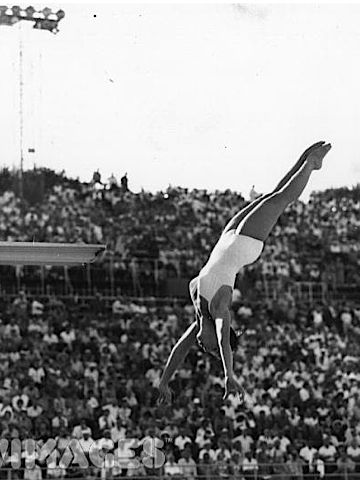
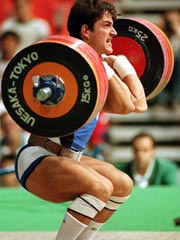
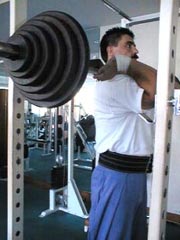 This is generally considered the optimum position - if you have the option, do it this way.
This is generally considered the optimum position - if you have the option, do it this way.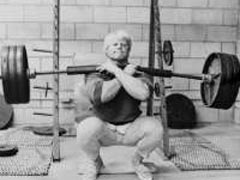 Another common method is to cross the arms over the bar, holding the left side with the right hand and vice versa. If the abovementioned Clean method is out of the question for you, try this.
Another common method is to cross the arms over the bar, holding the left side with the right hand and vice versa. If the abovementioned Clean method is out of the question for you, try this.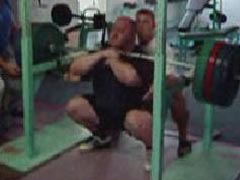 Whilst frowned upon by many purists, this technique is still used occasionally. Clasp your hands together and use them to push the bar onto your chest/front delts.
Whilst frowned upon by many purists, this technique is still used occasionally. Clasp your hands together and use them to push the bar onto your chest/front delts.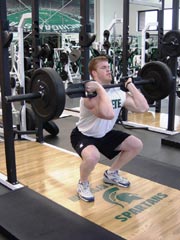 A much less common version (but intriguing nonetheless) is the Log Bar Front Squat. As you can see, a log bar prompts a vertical grip, which takes a similar amount of flexibility as the Clean grip.
A much less common version (but intriguing nonetheless) is the Log Bar Front Squat. As you can see, a log bar prompts a vertical grip, which takes a similar amount of flexibility as the Clean grip.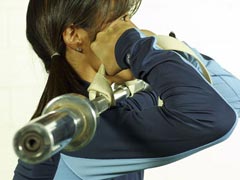 I noticed this yesterday in Mike Boyle's article
I noticed this yesterday in Mike Boyle's article 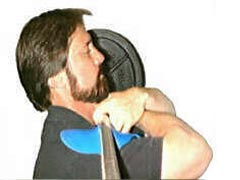 The Stringray device is designed to counter the basic deficiencies of the crossed arms approach. The two pads help keep the bar aligned and stable, allowing the widest possible grip to be used. The Stingray also lifts the bar slightly, keeping the weight over the front delts whilst keeping it away from your throat.
The Stringray device is designed to counter the basic deficiencies of the crossed arms approach. The two pads help keep the bar aligned and stable, allowing the widest possible grip to be used. The Stingray also lifts the bar slightly, keeping the weight over the front delts whilst keeping it away from your throat.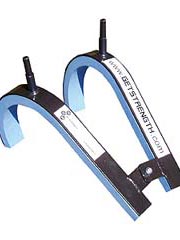 The
The 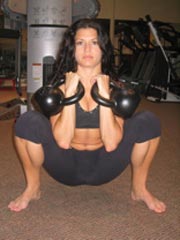 Got two kettlebells? Try this. Remember to Clean them one at a time.
Got two kettlebells? Try this. Remember to Clean them one at a time.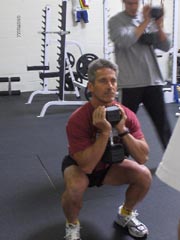 The Goblet Squat is often considered a separate exercise, however I've included it here for completeness. It can be performed either using a dumbbell as shown, or by grabbing a kettlebell 'by the horns'.
The Goblet Squat is often considered a separate exercise, however I've included it here for completeness. It can be performed either using a dumbbell as shown, or by grabbing a kettlebell 'by the horns'.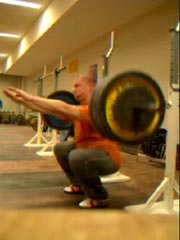 If none of the different holds shown above appeal, there's always the 'hands free' method (thanks
If none of the different holds shown above appeal, there's always the 'hands free' method (thanks 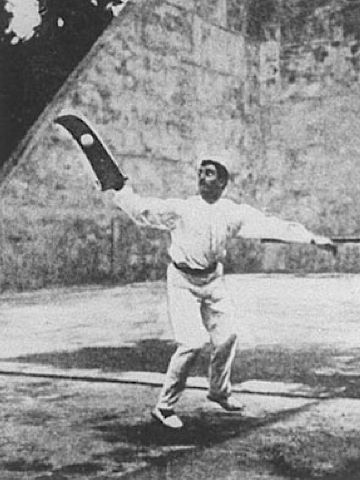
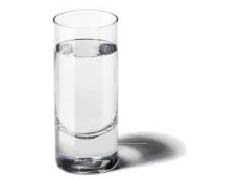 Most people seem to agree that drinking water is a good thing, and that it helps in many areas of health and fitness; from weight-loss to stress reduction. What seems to be less well defined - at least on the surface - is the advice to drink '8 glasses of water per day'.
Most people seem to agree that drinking water is a good thing, and that it helps in many areas of health and fitness; from weight-loss to stress reduction. What seems to be less well defined - at least on the surface - is the advice to drink '8 glasses of water per day'. Spring is definitely here, and it's the perfect time of year to go offline for a week and enjoy the Great Outdoors. Although there are no firm plans yet, that's exactly what I'll be doing. Until September 7, that is.
Spring is definitely here, and it's the perfect time of year to go offline for a week and enjoy the Great Outdoors. Although there are no firm plans yet, that's exactly what I'll be doing. Until September 7, that is.
 Finally, a HIT. Good condition, with box and a roll of film. Love it.
Finally, a HIT. Good condition, with box and a roll of film. Love it.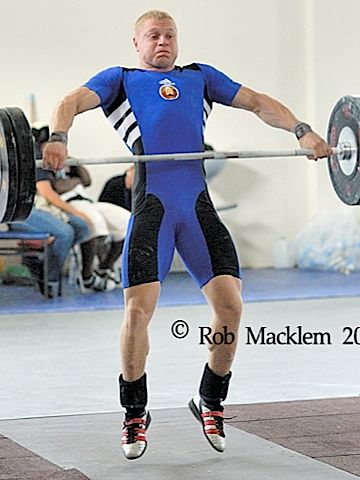 Another great week here at
Another great week here at 
